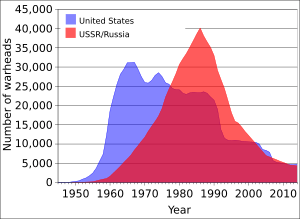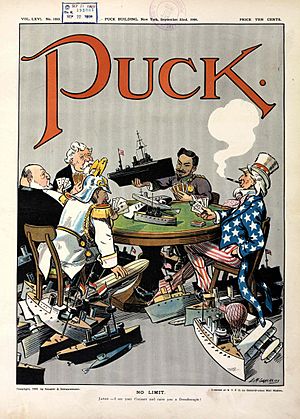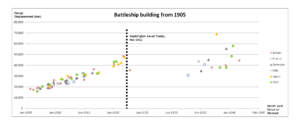Arms race facts for kids
An arms race happens when two or more groups, usually countries, try to build up their military power faster than each other. It's like a competition to see who can have the strongest army, the most weapons, and the best military technology. Unlike a sports race with a clear finish line, an arms race can go on and on, with each side constantly trying to get ahead.
Some experts wonder if arms races always lead to war. They often talk about something called the "security dilemma." This means that when one country builds up its defenses to feel safer, it might make other countries feel less safe. This can cause them to build up their own defenses, creating a never-ending cycle.
Contents
Famous Arms Races
From 1897 to 1914, a big naval (navy ship) arms race took place between the United Kingdom and Germany. Britain became worried because Germany was building its navy very quickly. This led to a costly competition where both countries built many powerful new warships called Dreadnoughts.
This tense race continued until 1914, when World War I began. After the war, the winning countries started another arms race. This one was stopped for a while by the Washington Naval Treaty, an agreement to limit naval weapons.
Other smaller naval races also happened around the same time. For example, Russia and the Ottoman Empire competed, as did the Ottomans and Greece. France and Italy also had their own naval competition. Later, in the 1930s, the United States and Japan were in a naval race. Even countries in South America like Brazil, Argentina, and Chile had a "dreadnought race" to build powerful battleships.
The Nuclear Arms Race During the Cold War

This was a competition to build and improve nuclear weapons. It happened during the Cold War, a long period of tension between the Soviet Union and the United States, along with their allies. This race was one of the main reasons the Cold War started.
Both sides believed the other had more or better weapons, like a "missile gap" or "bomber gap." This led them to spend huge amounts of money on weapons and build up massive collections of nuclear bombs. They also fought "proxy wars" around the world. These were conflicts where the superpowers supported different sides with their regular weapons, for example, in Korea and Vietnam.
After the dissolution of the Soviet Union and the end of the Cold War, the tension decreased. Both countries then reduced the number of nuclear weapons they had.
Some experts, like Charles Glaser, believe that many arms races were not helpful. They wasted money, made political relations worse, and increased the chance of war. However, arms races can sometimes be seen as useful for countries trying to stay safe. This might happen if new technology makes old weapons useless, or if a country is losing power and faces a rising opponent.
The Artificial Intelligence Arms Race
A military artificial intelligence arms race is a competition between countries to develop and use lethal autonomous weapons systems (LAWS). These are weapons that can make decisions and act on their own using AI. Since the mid-2010s, many experts have noticed that a new arms race is starting. Global superpowers are competing to create better military AI.
This race is driven by increasing tensions between countries. Some people even call it an "AI Cold War" between countries like the US and China.
Other Ways "Arms Race" Is Used
The term "arms race" can also describe other types of competitions.
An evolutionary arms race happens in nature. It's when two groups of living things, like a predator and its prey, keep evolving to get better at overcoming each other. For example, a rabbit might evolve to run faster to escape a fox, and then the fox might evolve to run faster to catch the rabbit. This idea is linked to the "Red Queen's Hypothesis," where both sides run as fast as they can but don't really get ahead of each other.
In technology, we see similar "arms races." For example, there's a constant competition between people who write computer viruses and the people who create antivirus software. Or, think about spammers who send unwanted emails and the companies that create email software to block them. Each side keeps trying to outsmart the other.
More generally, an arms race can describe any competition where there's no final goal, only the goal of staying ahead of others. It can also suggest that a lot of time and money is spent, but neither side truly gains a lasting advantage.
See also
- Nuclear arms race
- Arms control
- Arms industry
- Cyber arms race
- Driver safety arms race
- AI arms race
- Lewis Fry Richardson for his mathematical analysis of war
- Second Cold War
- Military–industrial complex
- Missile gap
- One-upmanship
- Revolution in military affairs
- Security dilemma
- Space race
- Weaponization of artificial intelligence
- Saint Petersburg Declaration of 1868



